Organic and Green Savings: Gardening Edition!
The next Green Moms’ Carnival, to be hosted on Monday, by the lovely Anna of Green-Talk, is all about gardening. Last spring, inspired by Anna and her great gardening posts I decided to try raising plants from seed for the first time. It was fun in the beginning.
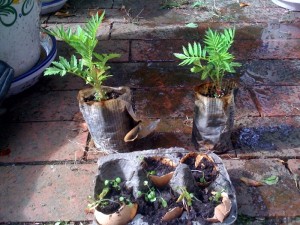
But unfortunately the plants never took.
Fact is, I’m not much for gardening. I can’t even keep an “indestructible” bamboo plant alive on my desk.
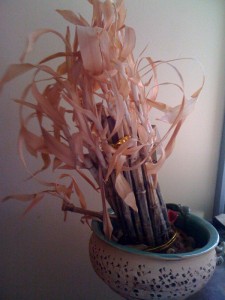
The only plants that survive in my garden are the really natural ones – you know, the ones that come up no matter what you do. (And the ones that our house’s former owner, a Master Gardener, planted and left for us!)
So my bad luck with gardening presented a dilemma for this carnival. What to write? What could I possibly contribute?
For the past few years, I’ve blogged on a semi-regular basis about organic and green savings. Most of the time I’ve focused on food. Never on gardening. So here you go – if I can’t pass along sage gardening advice, at least I can pass along a few tips on good gardening values.
Organic Gardening Soil & Other Organic Accoutrements
In the past few years, the organic gardening trend has really taken off. And frankly, it’s puzzled me a bit. For unless you live on soil that was previously treated with chemicals, herbicides and pesticides, odds are your soil is already organic! There’s no need for fancy “organic” soils and supplies. Save your money for more important organic supplies…plants and seeds.
Which Organic Seeds? Which Organic Plants?
It’s pretty cool to find all of the grocery stores stocking seed these days – even organic seed. But there’s a price differential – as with most things organic. At the local Giant and Safeway grocery stores in Bethesda, Maryland, you’ll pay .90 cents more per packet for organic seed versus conventional. Funny how it seems like a lot of money at the time – until you think of how much produce those seeds should yield!
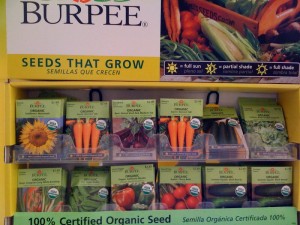
What are you really buying? For the home gardener, the most important thing about organic seed is that it guarantees that the plants you are growing will not be from genetically modified stock. So which plants are most likely to be genetically modified? In the US, the vast majority of corn, soy, and tomato crops are genetically modified. Concerns have been raised about what the ramifications may be of ingesting GMOs – a practice that has been banned in Japan and the EU. There may be some genetic modification of other crops, but it’s not as common as with corn, soy and tomato – so those are the plants and seedlings you should definitely buy organic. By all means, buy everything organic if you can – just to be on the safe side. But if not, spring for the big 3: tomatoes, corn and soy.
Gardening is Not Necessarily Green
One of the biggest lessons I’ve learned on this blogging journey is this: organic does not necessarily mean green. Green does not necessarily mean organic. Organic doesn’t mean fair trade. And the list goes on…..
Same with gardening. If you’re trying to live a more sustainable lifestyle, does buying plants in plastic containers make sense?
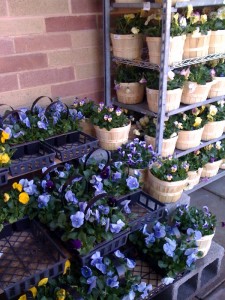
Not only is plastic made from petrochemicals (increasing our carbon footprints and contributing to global warming), but it doesn’t degrade in a landfill or compost heap. The manufacturing process is also highly toxic, often causing health problems for the people unfortunate enough to live nearby the manufacturing facilities. (For more on this, watch Tapped, The Movie).
Sometimes, the choice is easy, like it was at this Giant store. A wooden basket or plastic? For the same price? What an easy choice.
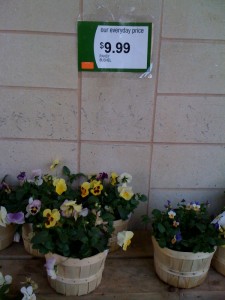
Other times, you may think you have no choice – just row after row of plastic seedling containers.
But there’s always a better way. Cardboard, egg crate, and other paper-based materials can all be re-used (and later composted) to make seedling pots.
Talk to your store’s manager. Ask if they can talk to their suppliers about more sustainable packaging. Even if they can’t change the packaging, surely they can start a take-back program for the little plastic pots. Write a letter. Ask your friends to do the same. You’d be amazed at what a little bit of consumer input can do!
Garden. Do it Organically or Not. But be Green. Don’t contribute more to the plastic waste stream in your quest to “be green” by planting a bit of garden space in your backyard.
For more tips on gardening, head on over to Green-Talk to hear what the rest of the Green Moms Carnival members have to say about gardening. And for more tips on living life with less plastic, check out Fake Plastic Fish.
— Lynn
Copyright OrganicMania 2010
Filed under Bethesda, Giant, Organic Prices, Product Recommendations, Savings Tips | Wordpress Comments (5) |Gardening with the Green Moms: Talk About Stress Relief!
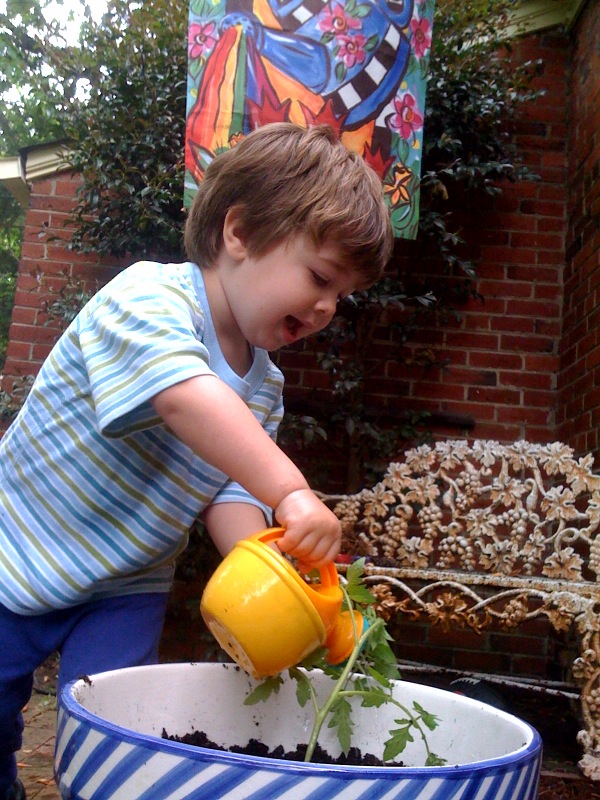
Did this photo make you smile? Admittedly, I’m biased since that’s my “Baby Boo,” but how could it not make you smile?
That’s one of the greatest things about gardening (and children). They bring us so many smiles. And when our lives are full of the hectic everyday busyness that is modern life, plus the unexpected curve balls that life lobs at you every now and then, well, who couldn’t use some stress relief?
Want to know how to get started with your spring garden? Check out a round-up of great gardening posts from the Green Moms Carnival over at Green and Clean Mom. My own post about recycled seed starter pots was belatedly added to the carnival after its launch, because I was …well…stressed out dealing with child advocacy and green advocacy issues; an elderly, sick mother; stitches for Baby Boo; and the everyday craziness that all of us face as parents.
Have you started a garden yet? It’s not too late! Leave a comment and share!
And if you just can’t get around to it this year, take a walk and go enjoy someone else’s garden!
— Lynn
Copyright OrganicMania 2009 .
Filed under Easy Green Weekend Projects, Green Ideas & Stuff, Green moms, Green Moms Carnival Home Page & Calendar, Savings Tips, Uncategorized | Wordpress Comment (1) |Getting Started with Seedlings: Make Your Own Recycled Starter Pack Containers
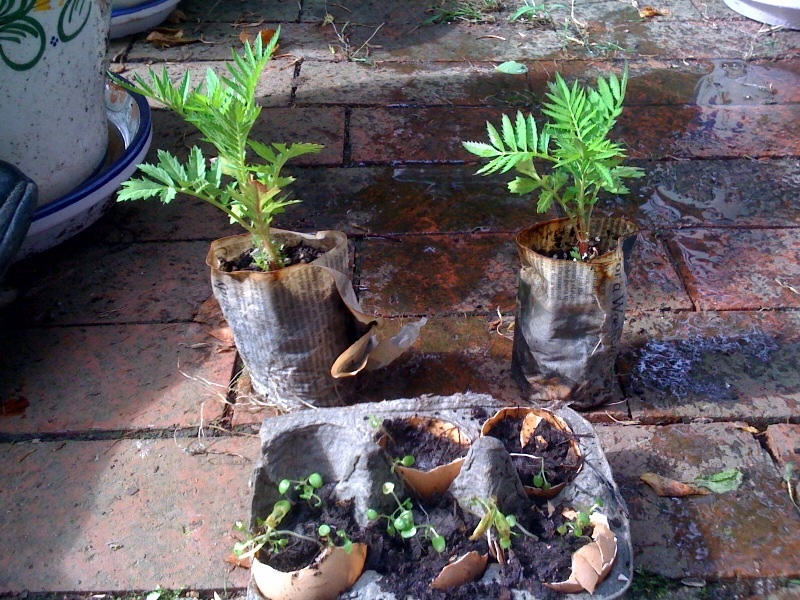
Success with eco-friendly seed pots!
Perhaps, like me, you’ve made the decision to try your hand at raising plants from seed this spring – only to discover that your eco-friendly plans go awry when you realize you have no containers on hand! A quick trip to my storage area didn’t turn up much, so I reached out to my bloggy friend Jess of The Green Phone Booth (and formerly of Surely You Nest), hoping we might be able to stage one of our rare reunions so that I could pick up some cast-off seed starter pots.
A died-in-the-wool Earth Mother who was raised by a Green Mom before they called themselves Green Moms, Jess went one better on me. She had no cast-offs to share, but she did share some of her gardening wisdom. She suggested toilet paper, egg shells, or newspapers. And knowing full well that those suggestions would leave me flummoxed, she helpfully pointed me to this great post from Planet Green, which suggests whipping up planting pots from egg cartons, yogurt containers, newspaper and toilet paper rolls.
The egg cartons seemed easiest to me – I’ve got plenty on hand and frankly, as I’m not really the artsy-crafty type, I found the instructions for the toilet paper and newspaper options a bit too complex.
Turns out fellow Green Mom Jenn Savedge, aka The Green Parent, is also a fan of egg cartons for seedlings, as she explains here. Here’s what works for me, based on tips from all three of these fabulous green women – JessTrev, Jenn Savedge and Jasmin Malik Chui.
1. Figure out how many seedlings you’re going to start, and make sure you have enough egg cartons and egg shells on hand.
2. Yes, as Jenn points out, you’ll want to wash those eggshells first with a gentle cleanser and water. I’m using the produce rinse for this job too!
3. Take a pin and poke a tiny hole in the bottom of each egg shell.
4. Fill with soil (hopefully organic compost from your compost bin), and drop several seeds inside.
5. Voila – once the seeds have sprouted, you can take the eggshells and the cardboard egg carton holders and plant them directly in the ground!
Not only is this a great project for home, but think about all those other times when you’re asked to come up with a craft project for the kids. This is a great spring craft project for school, scouting, or Sunday School. Works for me!
— Lynn
Note: As you can see, I updated this post with a pic of my successful seedlings sitting besides some newspaper pots I purchased at my CSA!
Copyright OrganicMania 2009
Filed under Easy Green Weekend Projects, Food, Green Ideas & Stuff | Wordpress Comments (9) | My StumbleUpon Page
My StumbleUpon Page



